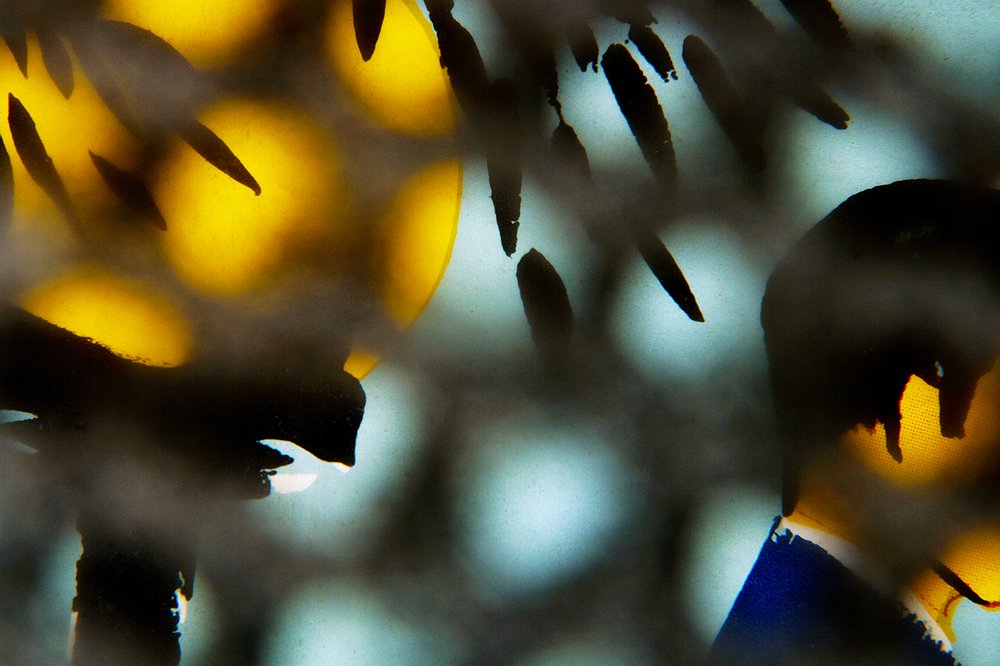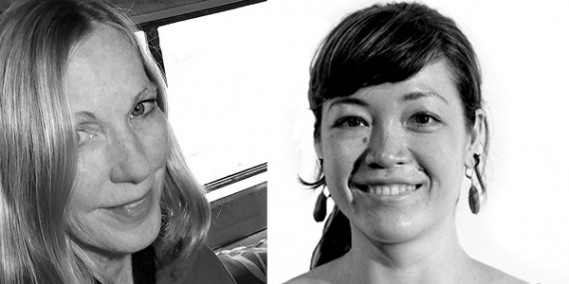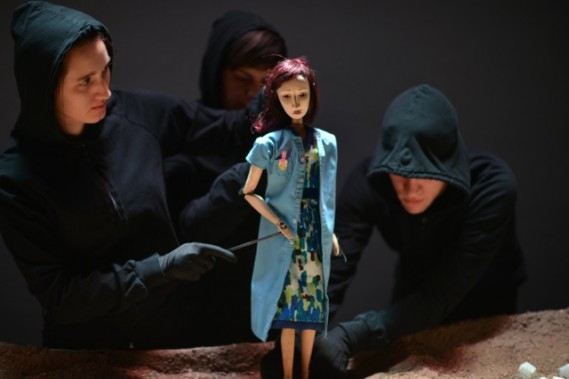Artist to Artist: Miwa Matreyek and Janie Geiser on Collaboration, Wonder and the Importance of Tinkering

As part of our “Artist to Artist” interview series, Miwa Matreyek and Janie Geiser sat down to discuss commonalities in their work. The following is an excerpt from their conversation. You can listen online to the full podcast, or subscribe through iTunes.
Miwa: We’re here talking about our work for Creative Capital. I just showed Janie my Creative Capital project, This World Made Itself, and I’ve seen a lot of Janie’s puppetry work as well as her films, and Janie’s seen my work. We’ve been in each others’ worlds for a few years. Janie was one of my mentors from CalArts who really inspired me to do performance, so it’s really thrilling to have this conversation.
Janie: Yeah, I’m very happy to be here talking with you in your apartment, where I can feel the presence. I see the collages that I’ve seen on your website. It’s really amazing. So, it might be a good starting place, thinking about your work as collage and how you combine images and how you went from still collages into performance and film.
Miwa: I actually consider the performances as a collage.
Janie: Oh absolutely!
Miwa: There’s the front and rear projection and I’m sandwiched in between and everything is going to collapse into those layers.
VIDEO: Excerpt from Miwa Matreyek’s Myth and InfrastructureJanie: It flattens out your body in this amazing way that makes you an equal part of that collage.
Miwa: Yeah. I started making animation from doing collages, basically. I started with Xerox collages, cutting out layers and then Xeroxing it, and then reconstructing that and Xeroxing it. But then once I started doing it on the computer, it was like, “Oh, the next step is to start moving them!” I think I identify most with the collage aesthetic, too, and the uncanniness of taking something familiar and making it unfamiliar, or taking something unfamiliar and making it familiar through collage. I see that in your work, too. Scale shifts are so interesting with collage. It’s funny how the mind and the eye can just take two really disparate ideas or images and, when you put them next to each other, it just completely shifts both of those worlds.
Janie: I like to work with collage, especially in my films—sort of less in performance work but more in the films—and I also love the way that the lens magnifies everything about the collage elements. So, in some of the films there might be an old figure moving through the frame, and you see the seams of the body; you see all of the degradation of the figure or in the collage elements. Somehow having them magnified and juxtaposed in the film frame gives them a different kind of life. I think that adding the element of time to the collage is part of what attracts both of us to the medium.
Miwa: Especially in your films, there’s such a richness of material. For me, now that I do performance, it’s adding another layer because I was working with still images. But in your films, there’s the collage of still images and textures but also 3D layers and paint that goes over it, and it really becomes a mix of material and materiality of everything, as opposed to just imagery.
Janie: Right. One of the things I like to do in constructing those is just to have everything there and make a composition, and then while I’m shooting I figure out what’s happening next, so there’s a live performance of the collage elements while shooting frame by frame—sometimes even moving things live while shooting frame by frame to get different rhythms. That’s where the performance is for me, in the process of making the film.
Miwa: I was looking at a lot of your films yesterday and today, and we were talking a little bit earlier about the presence of the body and physicality in my performance and also in your puppetry, but also in your films, where you have a lot of textural scenes where—I think it’s fabric?
Janie: Sometimes, yeah.
Miwa: And you’re just moving it in front of the camera. I also really love the presence of lighting in a lot of your animations, where there’s a paper cutout or a shape or a chair and you just see the presence of a light that’s flickering or moving in the space. It creates such an intimate space—maybe because I was watching it on my laptop—but it really feels like everything is just right in front of your nose, very, very close to you.
Janie: And, in a way, that’s how it feels when I’m shooting. I’m just right up in the materials, and that sense of the lighting is also happening live. I’m just moving my fingers in front of a light source to create shadows or moving a glass or some perforated object, either between the lens and the collage or between the light and the image.
Miwa: Not to just talk about your films, but when you make your films, is it, basically, you working on it? Or do you have people helping you?
Janie: Yeah, it’s completely just me. Which is a great contrast, for me, with the performances, which end up having 12 or 16 people sometimes. So there is an intimacy, and maybe that’s part of what you’re picking up.
Miwa: It definitely feels like someone is tinkering and making it. It feels very idiosyncratic, very much like one person’s world and one person is making it with their hands.
Janie: I’ve never really figured out a way to have anybody help me, and in a sense I don’t really want that.
Miwa: I’m kind of similar with my solo work and when I make short films. It’s very much about me just figuring stuff out on my own, as I go. I haven’t really figured out how to put this into words, but there’s something about artists who tinker and make things with their own hands and solve puzzles as they go in making work that I’ve always been interested in.
Janie: There’s almost like a handmade alchemy to it.
Miwa: Alchemy! Yeah!
Janie: It’s also just where process is important. The pleasure, for me, is in the shooting and in the making. It’s not something you can hold onto like an object. It’s passing by at every moment, so there’s that pleasure in seeing something actually happen.
Miwa: I would actually include your puppetry work in it, too, even though there’s other people in it—it feels very much like your world. I guess I’m contrasting that with larger theater productions or larger puppetry productions. It feels very much like, “This is Janie’s brain.” I’m sure you have helpers, but it’s very much about you.
Janie: Well, it’s certainly more like an auteur filmmaker would be. You have the conception and you have a vision for the piece, and then, of course, everyone is contributing hugely to making that happen. In a sense, choosing the people you are going to work with is part of what makes that happen. Just like Cloud Eye Control, the company you’re a part of, you have to make sure that people understand what you’re doing, and you have to notice their gifts and really want to create a place where they can expand what they’re doing, too. I love both things. I love working by myself in my little trailer studio, and I love working with groups of people and letting them take me where I really couldn’t go. On the last piece I did, Clouded Sulphur, I had two actors who were part of the process from the very beginning and I wasn’t even sure, when we started, what their exact role was going to be. There was a script by Erik Ehn that we were working with, so I knew there was text that we had to somehow incorporate. Through the long process of a year and a half of development, it emerged what their role would be in the piece. At first, they were actually working with the puppets as well, but it seemed to keep them from being able to do extreme things with their voices. So we eventually separated the puppets from the narrator-performers, which was actually, at the beginning, more the model I was looking at. I was looking at Bunraku theater as a source for the piece, but then it went another way for a while, and then came back to that. That was the most I’ve worked with actors in an extreme way, where the acting was equal to the puppetry in the piece, so it was an exciting thing to discover and completely came out of two actors’ willingness to go there and be part of that process and work with puppets. There were other actors who also did the voices for the puppets in the piece, and that was a terrain I knew more, so this was something really different for me.
Miwa: I guess, with my own stuff, I have my solo work of performance, and then the group work of Cloud Eye Control, and sometimes the transition is hard but certainly being with the group pushes me in ways that I maybe wouldn’t be comfortable with or think about for my own work, but I think it also makes it so that if I have ideas during Cloud Eye Control that don’t quite fit, I can just bring them back into my own work. That’s basically how I started. When I did my thesis piece, it was a lot of ideas that I had while working with Cloud Eye Control, because at school we made three different pieces; we collaborated every year I was at school, and there was stuff that I had in my back pocket that kind of started my own solo work. You were talking about how, working with other people you discover new things, but also that makes you discover things that you want to do in your own work…
Janie: They both inform each other and, in a sense, I don’t think of them separately—they’re all part of the same work. But definitely, working with collaborators pushes me immensely and I always bring what I learn back into the films. It may not be clear to other people, but even just different senses of rhythm can inform what I’m doing in films, too. And working with really strong designers, I grow as a visual artist. I usually design my own sets, but in this case I worked with a designer that I’d been wanting to work with for a long time, Sarah Krainin.
Miwa: Oh yeah!
Janie: Yeah! We had a very organic process.
Miwa: Wow. For Clouded Sulphur.
Janie: Which was this huge dirt set. So we started co-designing. I said, “I don’t know what this process is going to be but let’s just see what we can make.” And we both pushed it together up to a certain point, also inspired by someone else saying, “I see a big wall of dirt,” and we were both like, “Yeah, that seems great!” We tried to work with the puppeteers going up a wall of dirt, mocking that up with tables, and we saw that the puppeteers’ bodies were too big in that relationship, so we were like, “Let’s just put them behind the dirt, somehow.” At that point, I just said, “Sarah, you run with that.” So she came up with the shape. We kept playing around and refining it, but she had that last step, so it’s really her design. But it was such a great process for me to work that way with a designer, and I think I’ll do that again.
So, what did you do when you were a kid? I’m always curious—were you making art, as a kid? Is that something that’s always been with you, or did you come to that later?
Miwa: I was making art, but I’m not sure if it was very much more than other kids. I feel like, this is kind of cheesy but the place where I make work now is kind of similar to where I made it as a kid, where it was basically that I would go into my corner and make something that is going to be a nice surprise for my mom or friends or to whatever viewer. I want to make something surprising. When I was a kid, I feel like a lot of the artwork I was doing was either part of play or, “Oh, I’m making this thing that is going to be a gift”—a Mothers’ Day card for my mom, a painted card. I also remember liking to make things that were functional—taking a box and putting a really long drawing in it with things that spin to make a TV…
Janie: So you liked making contraptions. So that goes back to your tinkerer comment.
Miwa: Yeah, solving puzzles, which I think is a big part of my work. I mean, I think kids are just like that—solving puzzles and making something that’s your own invention.
Janie: There’s a pleasure in that. It’s interesting, you talking about this moment of surprise. That’s so much in your work, in a great way, and an element of the uncanny, which is very powerful in your work, and then also this sense of wonder. I was thinking about it—just watching the new piece, there’s this sense of wonder you’re creating from your own experience about why you’re creating the piece. The world is a wonder, and all of your work has that quality to it. But then there’s a double-wonder for the audience. We’re watching the performance of wonder and the way that it’s done is also a wonder to us.
Miwa: Double-wonder.
Janie: It’s double-wonder! That’s what I was thinking, “double-wonder.” So it’s very exciting! And this piece, I think, is very complex because it has double-wonder but it also has a lot of darkness in it.
Miwa: Yeah.
Janie: Which, we were talking earlier—the darkness is usually followed by some kind of hope. And the ending, which you think is a little pessimistic, I found actually hopeful. So I think there’s some part of this wonder that’s wondering at the horror of life as well as its beauty.
Listen online to the full podcast (47 Minutes)
Subscribe to Creative Capital podcasts through iTunes






